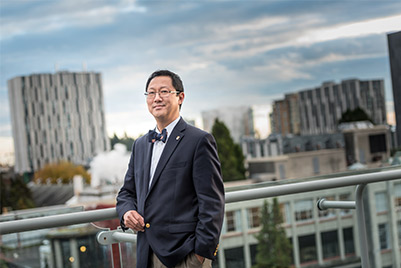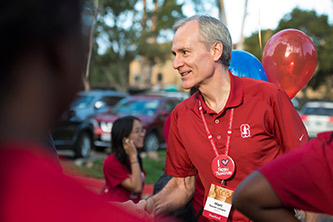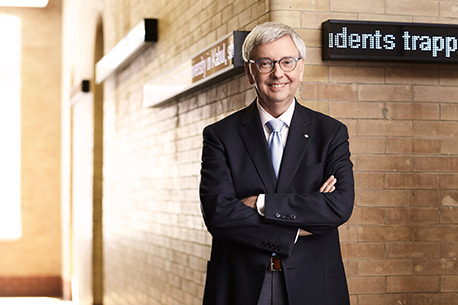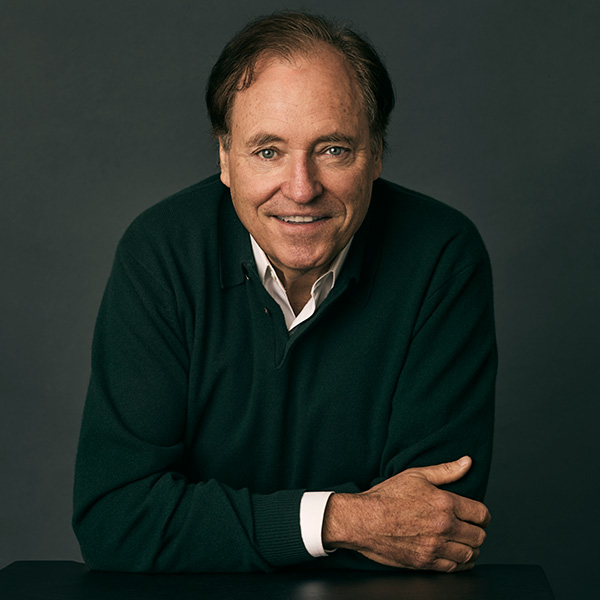Within the period of a month-a-half last year, it became clear that the future of three of the world’s top universities would be largely dependent on the leadership skills of a trio of McGill graduates.
On August 15, Santa Ono, PhD’91, became the new president of the University of British Columbia. September 1 marked the first official day of work for Marc Tessier-Lavigne, BSc’80, DSc’11, in his new role as the president of Stanford University. Later that month, Stephen Toope, BCL’83, LLB’83, was announced as the next vice-chancellor of the University of Cambridge. His appointment will begin in October.
In the most recent QS World University Rankings, Stanford was rated the second best university in the world, while Cambridge was ranked fourth. UBC was in 45th place. McGill – also led by a graduate, Principal Suzanne Fortier, BSc’72, PhD’76 – was ranked at number 30. So, according to QS, four of the world’s 50 finest universities are led, or soon will be, by McGill alums.
Ono, Tessier-Lavigne and Toope are all seasoned university leaders. Ono was the president of the University of Cincinnati for four years before coming back to Canada to lead UBC. Tessier-Lavigne had been the president of Rockefeller University in New York since 2011. Toope is the director of the University of Toronto’s Munk School of Global Affairs. Before that, he was UBC’s president from 2006 to 2014.
The three men recently shared their thoughts with the McGill News on the challenges facing universities and the role that university presidents play. One thing we learned: If you invite Ono and Toope to the same dinner party, steer the conversation away from Love Story. Otherwise, things could get awkward.

Santa Ono
According to the Cincinnati Business Courier, Santa Ono’s presidency at the University of Cincinnati “is widely considered one of the most successful tenures in UC history.” Ono was a popular figure in the city, thanks, in part, to his deft use of social media. There weren’t many job offers that could have lured him away from Cincinnati – but he received one that did.
His father was a professor of mathematics at UBC and Ono was born in a hospital affiliated with the university. “Returning to UBC was literally life coming full circle for me,” says Ono.
A highly regarded medical scientist whose work focuses on the immune system and eye inflammation, Ono is also a trained musician known to break out his cello now and then. An advocate for mental health issues, Ono has spoken candidly about his own struggles with depression as a young man. Inside Higher Ed named him America’s most notable university president in 2015 and the American Council on Education recently honoured him for his contributions to diversity in higher education.
Ono met his future wife Wendy Yip, BSc’86, at McGill while pursuing doctoral studies in experimental medicine.
What do you see as the biggest challenges facing higher education in the 21st century?
In North America there has been a steady decrease in support from provinces and states of our great public universities. This, coupled with a mandate to freeze or decrease the cost of education for students, has created tremendous pressure to create new funding models for public universities. The American Academy of Arts & Sciences’ Lincoln Project rightfully frames the challenge as a threat to America’s global competitiveness. The same kind of dialogue and planning needs to occur in Canada to ensure that our public research universities remain among the world’s best.
Access and inclusion is another major challenge. We need to continue to create programs and platforms to diversify the faculty, staff and students of our universities, so that the best and brightest can gain access irrespective of their origins, beliefs or ability to pay. In Canada, we need to work hard to ensure that First Nations youth have the same opportunities for educational attainment as other Canadians.
A third challenge I see across North America is one of academic leadership. We are in the midst of a complete renewal in presidential leadership of our major universities. And yet, there is a very small and diminishing pool of qualified individuals to take on these major administrative responsibilities. It is very important that the sector develop more academic leadership development programs and for institutions to be proactive in creating succession plans. At present, leadership selection at even our finest universities is reactive rather than strategic.
When you first became a university president, what surprised you the most about the job?
When I first became president of the University of Cincinnati, I was surprised by the amount of time I needed to spend overseeing intercollegiate sports. Although I am admittedly a big sports fan, I’m pleased that I can focus much more of my time at UBC on strengthening the core academic missions of the university as president of UBC.
What’s the most misunderstood part of the job?
I would say that the biggest myth about the university presidency is that the president has considerable power. In reality, in a shared governance model, the president has very little actual power. Whatever influence a president has comes from the ability to bring people together and to frame issues and to lead by consensus.
What’s the best part of the job?
My two favourite moments in an academic year are welcoming new first year students to the university and graduation ceremonies. Paramount among the many contributions universities make to society is that of education of the next generation. Watching the positive transformation of young lives is easily the best part of the job.
When you were a student at McGill, what was your favourite place on or near campus?
I loved spending time at Thomson House. Not only was it a great place to meet other graduate students over a pint of beer, it was a place where I played chamber music.
What was the most important thing you learned at McGill?
I’d say that I was strongly influenced by the ethos at McGill. The long tradition of research excellence was pervasive and set a tone for reaching for the highest in everyone. I’ve tried to keep that with me everywhere I go.
What’s your favourite university-themed film or TV show?
I have to admit that Love Story is my favourite. It was the first time I became cognizant of Harvard University. After watching it a few years later, I set my sights on one day studying at Harvard, and, wilder still, perhaps one day becoming a Harvard professor. My interest in the movie grew even more when, while at McGill, I learned that Principal David Johnston played for the Harvard hockey team and was the inspiration for a character in the movie.
Remarkably, my dream came true as I would spend a decade of my life at Harvard, first as a fellow in biochemistry and molecular biology, then as an associate professor. And one of the most memorable moments for me following my selection as UBC’s 15th president and vice-chancellor was receiving a phone call from Governor General David Johnston. As my McGill principal, he joked that I was “one of his children”, and that he was proud of me.

Marc Tessier-Lavigne
After earning a Rhodes Scholarship at McGill, Marc Tessier-Lavigne boarded the Queen Elizabeth 2 in New York to travel across the Atlantic with other North American Rhodes recipients bound for Oxford. When he first got on the ship, he was planning to do a PhD in physics. By the time he disembarked, he had settled on becoming the first student at Oxford “in living memory” to do a joint philosophy/physiology degree instead.
It turned out to be a pivotal decision. The studies in physiology helped prepare him for a future as a groundbreaking neuroscientist – Tessier-Lavigne is credited with leading the first research team to identify one of the molecules that play major roles in directing nascent neural connections.
The philosophy studies were no doubt useful in equipping him for the leadership roles he has taken on.
As the executive vice president for research at Genentech, he oversaw the work of 1,400 scientists for the company that developed such high-profile cancer drugs as Avastin and Herceptin. As the president of Rockefeller University, he spearheaded a bold expansion of the campus and led the university’s efforts in raising nearly $1 billion during its last capital campaign.
What do you see as the biggest challenges facing higher education in the 21st century?
Preserving accessibility and affordability for students is a big one. Colleges and universities are engines of opportunity and social mobility, and broad access to them is important. Sustaining financial support for research also is critical, because the discoveries at research universities today are central to economic growth and quality of life tomorrow.
When you first became a university president, what surprised you the most about the job?
The range of issues one deals with on a daily basis is amazing. The work includes planning for the long-term sustainability of the academic enterprise; engaging with the immediate needs of students, faculty, staff and other stakeholders; and leading the operations of what is essentially a small city. The breadth of subject matter is fascinating and demanding.
What’s the most misunderstood part of the job?
There is still a misperception that university presidents lead institutions that are ivory towers, separate and apart from the world. The universities where I have worked are vibrant, engaged with the world, eager to contribute. The education, fundamental research and applied research performed in universities are directly connected with the life of the broader world.
What’s the best part of the job?
As president of Stanford, I have the opportunity to meet so many talented and fascinating people from across the university community – students, faculty, staff, alumni – and hear their stories. Those personal stories make up the story of the university. Our diverse community of people is the foundation of our strength, and I’m fortunate to have the chance as part of my work to meet and learn from so many of them.
When you were a student at McGill, what was your favourite place on or near campus?
Because of its architecture and landscaping, the campus itself is lovely and surprisingly intimate, especially given how large the community is. I also loved the fact that I could feel the urban buzz simply by crossing Sherbrooke Street and walking a few blocks, but also lose myself in nature on Mount Royal. McGill occupies a very special location in a very special city.
What was the most important thing you learned at McGill?
By having the chance to interact with so many smart, talented people of such diverse backgrounds and interests, I learned to appreciate the full tapestry of human experience. I was also inspired by my fellow students’ desire to change the world for the better.
I understand that your parents were in the military and that you were often on the move as a child. How do you think that influenced you?
It gave me an adaptability to change that I think is valuable. Between the ages of six and nine, I went to three different schools in three different countries with two different languages – in Canada, England and Belgium. Change wasn’t easy, but it always helped me to grow in new ways, and to welcome change rather than be fearful of it.
There probably aren’t too many neuroscientists who have studied physics and philosophy. What impact has that had on your career and the way you see universities?
Love of learning has always driven my academic work – I have always just started with things that interested me and gone from there. But I do believe a broad education is important preparation for living in a complex and quickly changing world. Most people will have many careers over the course of their lives, and success even within one field requires drawing upon knowledge and skills from many other fields.
What’s your favourite university-themed film or TV show?
Chariots of Fire. Camaraderie, challenging tradition, and the quest for greatness – with a great soundtrack to boot.

Stephen Toope
The University of Cambridge will soon do something it has never done before in its more than 800 years of existence – hand the keys to the vice-chancellor’s office to a non-Briton.
Stephen Toope, who served as McGill’s dean of law from 1994 to 1999, will become Cambridge’s new vice-chancellor next fall. “I sense that the advisory committee and the university council were actively looking for an outsider,” he says. Not a complete outsider, though. Toope earned his PhD from Cambridge in 1987.
After leaving McGill, Toope became the first president of the Pierre Elliott Trudeau Foundation before taking on the presidency of UBC. Apart from his current duties at the Munk School of Global Affairs, he is also the president of the Federation for the Humanities and Social Sciences.
During his law studies at McGill, Toope was the editor-in-chief of the McGill Law Journal. An expert on international law and human rights law, he chaired the United Nations Working Group on Enforced or Involuntary Disappearances. With Toope as its president, UBC focused on improving the student experience, increased its research funding and embarked on a successful $1.6 billion fundraising campaign.
What do you see as the biggest challenges facing higher education in the 21st century?
Re-establishing a balance between providing a broad, liberal education that prepares people for citizenship and diverse social contributions, and helping students orient towards a rewarding career. The pressure for the last couple of decades has been firmly towards the latter objective, with the former being called into question.
Another challenge is to help students function more effectively in a world that is increasingly inter-cultural. Despite Brexit and the recent U.S. election, I don’t think that the trend towards cultural mixing in the Western world is likely to be turned back. All our students will need to work with people from many different cultural backgrounds even if they never leave their home countries. Cultural fluency will be as important as technological literacy.
When you first became a university president, what surprised you the most about the job?
How many times I had to have my picture taken!
Also, the degree to which I had to focus on working with, and pushing back against, our principal funders – governments at the federal and provincial levels.
Students often express worry about the intrusion of the corporate world into the decision-making of universities. In my experience, that is mostly a red herring. Corporations, at least in Canada, don’t care that much about higher education; the hard part is to get them to engage at all. But governments often fail to recognize the crucial need for autonomy of the university. From time-to-time, they try to apply pressure in ways that are quite disquieting.
What’s the most misunderstood part of the job?
How much fun it is to try to move forward a very complicated and crucially important social institution. Hard, yes. Rewarding? Amazingly so.
What’s the best part of the job?
The incredible, passionate people that one works with every day: students, faculty members, staff members, alumni, donors, volunteers on the board and elsewhere.
When you were a student at McGill, what was your favourite place on or near campus?
Rue Saint-Laurent for its diversity and vitality.
What was the most important thing you learned at McGill?
Collegiality. I saw it in the faculty members in Law and I experienced it as a student. It makes life so much more rewarding than seeing every interaction as a competition.
The Varsity, a Cambridge student paper, noted your reputation for “theatricality” – a performance of the Eurythmics’ ‘Sweet Dreams’ with the UBC student president was mentioned. Any comment?
In college, I thought that I might become an actor. Instead I became a lawyer and professor – an actor, in other words.
What’s your favourite university-themed film or TV show?
Sadly none. Most are either saccharine (Love Story) or ridiculously over-the-top (Paper Chase). I like how the old Inspector Morse series riffs off life in Oxford, though. The university is a gorgeous backdrop; but the portrayals of university fellows are almost uniformly negative!
You’ve been quoted as saying, “I despise Twitter, truthfully.” Does that still hold?
Yes. Two things worry me. First, the tendency of social media to require instant reaction; the opposite of reflection and considered engagement. Second, the increasing fractionation of society into “followers” of one or another ideological camp. Social media facilitates and exacerbates “tribal” instincts. I know that there are real strengths in social media – for example, allowing groups to self-organize and sharing information quickly. But I think that a strong critical voice is still needed.
Story Update: Santa Ono became the president of the University of Michigan in 2022. Marc Tessier-Lavigne stepped down as president of Stanford University in 2023. Stephen Toope became the president and CEO of the Canadian Institute for Advanced Research in 2022.


